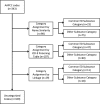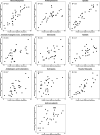Can poison control data be used for pharmaceutical poisoning surveillance?
- PMID: 21422101
- PMCID: PMC3078673
- DOI: 10.1136/jamia.2010.004317
Can poison control data be used for pharmaceutical poisoning surveillance?
Abstract
Objective: To determine the association between the frequencies of pharmaceutical exposures reported to a poison control center (PCC) and those seen in the emergency department (ED).
Design: A statewide population-based retrospective comparison of frequencies of ED pharmaceutical poisonings with frequencies of pharmaceutical exposures reported to a regional PCC. ED poisonings, identified by International Classification of Diseases, Version 9 (ICD-9) codes, were grouped into substance categories. Using a reproducible algorithm facilitated by probabilistic linkage, codes from the PCC classification system were mapped into the same categories. A readily identifiable subset of PCC calls was selected for comparison.
Measurements: Correlations between frequencies of quarterly exposures by substance categories were calculated using Pearson correlation coefficients and partial correlation coefficients with adjustment for seasonality.
Results: PCC reported exposures correlated with ED poisonings in nine of 10 categories. Partial correlation coefficients (r(p)) indicated strong associations (r(p)>0.8) for three substance categories that underwent large changes in their incidences (opiates, benzodiazepines, and muscle relaxants). Six substance categories were moderately correlated (r(p)>0.6). One category, salicylates, showed no association. Limitations Imperfect overlap between ICD-9 and PCC codes may have led to miscategorization. Substances without changes in exposure frequency have inadequate variability to detect association using this method.
Conclusion: PCC data are able to effectively identify trends in poisonings seen in EDs and may be useful as part of a pharmaceutical poisoning surveillance system. The authors developed an algorithm-driven technique for mapping American Association of Poison Control Centers codes to ICD-9 codes and identified a useful subset of poison control exposures for analysis.
Conflict of interest statement
Figures


Similar articles
-
Poison-related visits in a pediatric emergency department: A retrospective analysis of patients who bypass poison control centers.Am J Emerg Med. 2020 Aug;38(8):1554-1559. doi: 10.1016/j.ajem.2019.158418. Epub 2019 Aug 27. Am J Emerg Med. 2020. PMID: 31493977
-
Accidental pharmacological poisonings in young children: population-based study in three settings.Clin Toxicol (Phila). 2018 Aug;56(8):782-789. doi: 10.1080/15563650.2017.1422509. Epub 2018 Jan 15. Clin Toxicol (Phila). 2018. PMID: 29334809
-
Unintentional Pediatric Poisoning Exposures in an Emergency Department: A Comparison of Poison Control Center Referrals and Caregiver Self-Referred Visits.Pediatr Emerg Care. 2021 Dec 1;37(12):e1397-e1401. doi: 10.1097/PEC.0000000000002059. Pediatr Emerg Care. 2021. PMID: 32149986
-
Incidents of potential public health significance identified using national surveillance of US poison center data (2008-2012).Clin Toxicol (Phila). 2014 Nov;52(9):958-63. doi: 10.3109/15563650.2014.953171. Epub 2014 Sep 1. Clin Toxicol (Phila). 2014. PMID: 25175899 Free PMC article. Review.
-
International Poison Information Center data collection capabilities.Vet Hum Toxicol. 1995 Jun;37(3):246-8. Vet Hum Toxicol. 1995. PMID: 7571358 Review.
Cited by
-
Systematic review of surveillance by social media platforms for illicit drug use.J Public Health (Oxf). 2017 Dec 1;39(4):763-776. doi: 10.1093/pubmed/fdx020. J Public Health (Oxf). 2017. PMID: 28334848 Free PMC article.
References
-
- Centers for Disease Control and Prevention (CDC) Unintentional poisoning deaths—United States, 1999–2004. Morb Mortal Wkly Rep 2007;56:93–6 - PubMed
-
- Guyer B, Mavor A; Institute of Medicine Committee on Poison Prevention and Control Forging a poison prevention and control system: report of an Institute of Medicine committee. Ambul Pediatr 2005;5:197–200 - PubMed
-
- Middleton K, Hing E, Xu J. National Hospital Ambulatory Medical Care Survey: 2005 outpatient department summary. Adv Data 2007;389:1–34 - PubMed
-
- Nawar EW, Niska RW, Xu J. National Hospital Ambulatory Medical Care Survey: 2005 emergency department summary. Adv Data 2007;386:1–32 - PubMed
-
- Adams PF, Barnes PM, Vickerie JL. Summary health statistics for the US population: National Health Interview Survey, 2007. Vital Health Stat 10 2008;238:1–104 - PubMed
Publication types
MeSH terms
LinkOut - more resources
Full Text Sources
Medical

